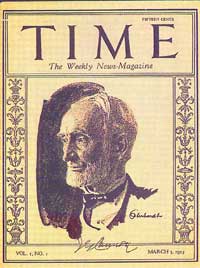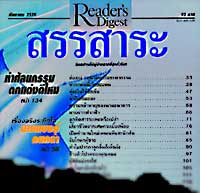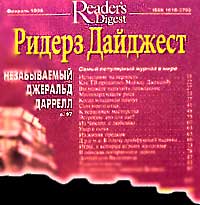Print Media 10 |
|
Magazines - Historical Background, Part II
Newsmagazines With the approach of international conflict in Europe and the beginning of World War I, magazines started featuring articles on international issues. Facing threats from Germany, the British conducted an open campaign to lure the United States into the looming war–going so far as to plant stories of German atrocities in magazines (that they knew that U.S. magazines had a habit of copying). Many of the stories were false, but they still had the effect of starting to inflame U.S. attitudes against Germany. Even so, there was considerable opposition in the United States to becoming embroiled in a world war. President Woodrow Wilson, who reportedly regularly read English magazines, was convinced that the United States should enter the war. Eventually he was able to won over a major part of the U.S. population. As the implications of the situation become more evident, people in the United States started relying more and more on newspapers and magazines for information on the With the heightened interest in world events, another opportunity presented itself–an entire magazine devoted to news. In 1923, Henry Luce, who had just graduated from Yale, begged and borrowed $86,000 from friends and relatives to start Time magazine. The first edition is shown here. It was four years before Time saw a profit, but once it got rolling, it moved on to make magazine history. Among other things, Time established a distinct style of reporting and writing. The term "timespeak" was coined to cover the magazine's "cut-to-the-chase," sometimes irreverent, but always authoritative approach. A decade or so later, two other newsmagazines appeared: U.S. News (later to be known as U.S. News and World Report) and Newsweek. Neither, however, has had the success of Time. By 2002, a trend was seen in newsmagazines to move away from hard news and shift their focus toward more feature (soft news) articles. There is reportedly less reader interest in hard news. By the time people get these magazines they are already familiar with news events from watching cable news channels. Although the news channels may be able to provide more up-to-the-minute information, they do not provide the depth and perspective associated with newsmagazines.
Although most general interest magazines (magazines with internal specialization) have ceased publication, a noteworthy exception is the Reader's Digest. Founded in 1922 by DeWitt and Lila Wallace, the Digest has tried throughout the years to offer something to everyone by condensing (digesting) articles from a wide variety of publications.
The Digest is published in several foreign language editions. The version represented on the left above is in Tai and one on the right is in Russian. A large part of this magazine's subscription success in the United States is based on extensive use of contests and targeted mail.
Women's magazines represent the most financially successful magazine category. Advertisers are fond of these publications because they target women, the segment of the population that buys the most consumer products. One of the most successful groups of women's magazines has become known as the Seven Sisters. These are Better Homes & Gardens, Family Circle, Good Housekeeping, Ladies' Home Journal, McCall's, Redbook, and Woman's' Day. Reaching much younger female demographics are magazines such as Cosmopolitan, Seventeen, and YM. Cosmopolitan started out as a general interest magazine, even featuring many noteworthy muckraking investigative pieces. However, when TV came along and spelled the demise of most of the general interest magazines, "Cosmo" had a new birth as a magazine for young woman with an interest in men, sex, and personal success.
And, speaking of sex, that's a topic that has long been a staple of men's magazines. The first major "glossy" men's magazine was Esquire, which was founded in 1933. Esquire featured pinups and impressive literary features. In 1953, Hugh Hefner, who was originally on the staff of Esquire, founded Playboy. The first edition contained nude photos of Marilyn Monroe–before she became something of a superstar. Hefner didn't put a date on the magazine because he didn't know if there would ever be a second edition. However, it sold out as soon as it hit the newsstands. Subscriptions to Playboy soon surpassed those of Esquire. Although Playboy is sometimes just associated with nude photos, it made its mark in magazine history for three additional reasons. First, it featured articles by top writers (who were paid extremely well for their contributions); second, Hugh Hefner's "philosophy" writings brought into focus sexual issues that publications had previously only flirted with; and, finally, the publication started the Q & A interview concept that many magazines subsequently copied. At its peak, Playboy sold more than seven million copies a month. However, with the advent of explicit cable TV channels and more explicit magazines, the appeal of the Playboy has diminished. Playboy sales also suffered when moralists such as Attorney General Edward Meese launched crusades against what they saw as "pornography." Meese was able to get magazines such as Playboy banned (a least for a time) in stores such as the 7-Eleven. Meese, who's views on pornography were well known, was put in charge of a government commission to determine if pornography was harmful. The previous government studies had found that it wasn't, and for political reasons the conservative Republican administration reportedly wanted to try to show otherwise. But, as Not all men's magazine dwell on sex. Other popular magazines include Popular Science and Field & Stream.
Magazines such as Harper's and Atlantic appeal to the so-called intelligentsia. These magazines, which date back to the 1850s, typically go into depth on cultural and political issues. But, they have a limited audience, and, as a result, they have had a hard time surviving. At the same time, their influence among selected audiences can be significant. The New Republic, Nation, and Progressive have liberal traditions. Others, such as William Buckley's National Review appeal to conservatives. The latter publication, which in some ways, is much more impressive than it's liberal counterparts, loses more than $100,000 a year. It is kept afloat largely by donations from conservative factions.
The "trades" are limited circulation magazines designed to serve professionals working in specialized areas. Some, especially those that derive most of their income from paid subscriptions, serve their professions with timely, accurate, and unbiased articles. Along with the Internet and professional conferences, these publications are relied upon by a wide variety of professionals to say current with developments in their fields. In particular, the trade publications of McGraw-Hill and Crain are noted for their honest, hard-hitting reporting of the industries they cover. Other trades--primarily those that depend heavily on advertising for their survival--may feature "reviews" of products and services that are simply puff pieces designed to support the views of advertisers. Rather than present objective articles, these publications carefully avoid anything that would hurt their advertisers, and do little more than expand on the concepts put forth in their paid advertising. It's often a tip-off, if you note that a trade publication with large ad for a product also features a positive article on the same product. In the next chapter we'll finish this topic, and then turn to economics and careers. |
|
To next module To
index © 1996 - 2005, All Rights Reserved.
|

 worsening conditions.
worsening conditions. 

